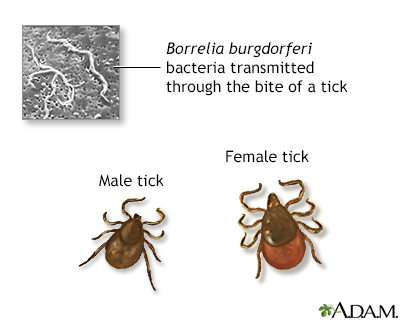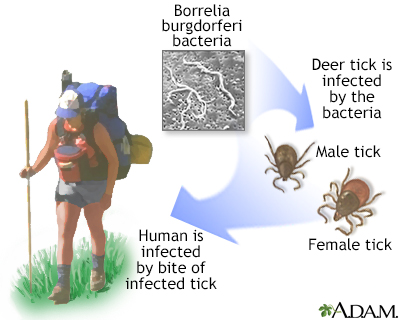Lyme disease - what to ask your doctor
Lyme disease is a bacterial infection that is spread through the bite of one of several types of ticks. The disease can cause symptoms including bull's eye rash, chills, fever, headache, fatigue, and muscle pain.
Lyme disease
Lyme disease is a bacterial infection that is spread through the bite of one of several types of ticks.

Below are some questions you may want to ask your health care provider about Lyme disease.
Lyme disease - Animation
Having a tick attached to your body isn't just getting a little too close to nature. The tick can make you seriously ill with Lyme disease. Lyme disease is caused by bacteria called Borrelia burgdorferi. Blacklegged ticks carry these bacteria. The ticks pick up the bacteria when they bite mice or deer that are infected with Lyme disease. You can get the disease if you are bitten by an infected tick, mostly in northeastern states and on the West Coast. The good news is that usually a tick has to be attached to your body for 24 to 36 hours to infect you. The bad news is that blacklegged ticks are so small they're almost impossible to see. Many people with Lyme disease never even see a tick on their body. But most people bitten by a tick do NOT get Lyme disease. So, how do you know for sure that you have Lyme disease? The flu-like symptoms of Lyme disease usually start days or weeks after you've been bitten. You might have Itching all over your body; Chills, fever, and light headedness; Or perhaps a Headache, muscle pain, and a stiff neck. You'll probably see a bull's eye rash on your body. It can get pretty big. After a few weeks, the muscles in your face might feel weak or even paralyzed. Your knees and other joints may swell and hurt. You might even notice your heart skipping some beats. Eventually, your muscles might move strangely, you may feel numbness or tingling, and you may start to have trouble speaking. A doctor will test your blood for antibodies that are trying to fight the bacteria in your blood. One of these tests is called the ELISA test, and you'll often have a second test called the Western blot test to confirm you have Lyme disease. To treat Lyme disease, you may need to take antibiotics for up to a month. Pain medicines from the drug store can help soothe your joint stiffness. If it's caught early, Lyme disease is pretty easily treated. Without treatment, you can have heart, muscle, and even nerve problems. So the next time you're out in the woods or high grass, wear protective clothing, and do check yourself for ticks once you get home.
Questions
Where on my body am I most likely to get a tick bite?
- How large are ticks and tick bites? If I have a tick bite, will I always get Lyme disease?
- Can I get Lyme disease even if I never noticed a tick bite on my body?
- What can I do to prevent getting tick bites when I am in a wooded or grassy area?
- In what areas of the US am I more likely to get a tick bite or Lyme disease? At what time of the year is the risk higher?
- Should I remove a tick if I find one on my body? What is the proper way to remove a tick? Should I save the tick?
- How can I protect myself from tick bites and Lyme disease?
If I get Lyme disease from a tick bite, what symptoms will I have?
- Will I always have symptoms soon after getting Lyme disease (early or primary Lyme disease)? Will these symptoms get better if I am treated with antibiotics?
- If I do not get symptoms right away, can I get symptoms later? How much later? Are these symptoms the same as the early symptoms? Will these symptoms get better if I am treated with antibiotics?
- If I am treated for Lyme disease, will I ever have symptoms again? If I do, will these symptoms get better if I am treated with antibiotics?
How can my provider diagnose me with Lyme disease? Can I be diagnosed even if I do not remember having a tick bite?
What are the antibiotics used to treat Lyme disease? How long do I need to take them? What are the side effects?
Will I have a full recovery from my Lyme disease symptoms?
Is there a vaccine for Lyme disease?
Reviewed By
Frank D. Brodkey, MD, FCCM, Associate Professor, Section of Pulmonary and Critical Care Medicine, University of Wisconsin School of Medicine and Public Health, Madison, WI. Also reviewed by David C. Dugdale, MD, Medical Director, Brenda Conaway, Editorial Director, and the A.D.A.M. Editorial team.
Centers for Disease Control and Prevention website. Lyme disease. www.cdc.gov/lyme/index.html. Updated May 15, 2024. Accessed July 30, 2024.
Steere AC. Lyme disease (Lyme Borreliosis) due to Borrelia burgdorferi. In: Bennett JE, Dolin R, Blaser MJ, eds. Mandell, Douglas, and Bennett's Principles and Practice of Infectious Diseases. 9th ed. Philadelphia, PA: Elsevier; 2020:chap 241.
Wormser GP. Lyme disease. In: Goldman L, Cooney KA, eds. Goldman-Cecil Medicine. 27th ed. Philadelphia, PA: Elsevier; 2024:chap 296.



 All rights reserved.
All rights reserved.